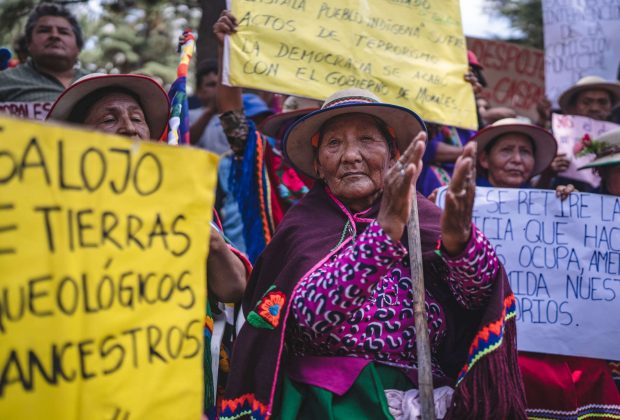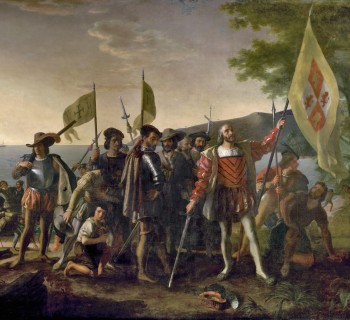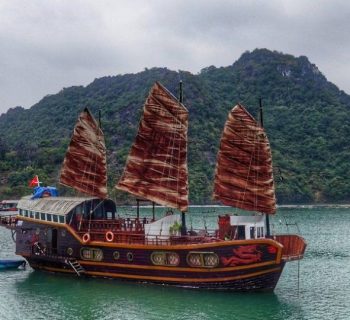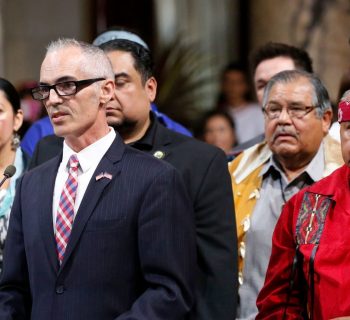To fight Columbus’s violent legacy, we need to engage in radical climate action and reject greenwashing technologies.
By Amrah Salomon | TruthOut | OCT. 9, 2023 | Photo by Taylor Rees
On September 28, 2023, a little over a week before Indigenous Peoples’ Day, an Akimel O’odham and Hopi climate activist, Jacob Johns, was shot by a Trump supporter at a vigil in northern New Mexicoconfronting the political support for bringing back monuments of colonizers that had been removed during the 2020 mass movement against racial violence. The community rally was expressing discontent with a monument to Juan de Oñate y Salazar, a 17th-century Spanish governor of the New Mexico territory responsible for a massacre of Pueblo peoples — not Christopher Columbus — but the battle over monuments to Oñate mirrors the issue of Columbus Day and the question of how to address monuments to genocide and slavery that symbolize investments in white supremacy today.
That this question is still answered with violence and the attempted murder of Indigenous people is not surprising. It is also not surprising that the Indigenous victim of racial violence spurred by the monument debate is also a climate activist and environmental protector. But the vapid and tokenizing responses of those who claim to be in solidarity with Indigenous peoples, particularly those in environmental and climate activism, to the deeper issues that the movement to abolish monuments to colonialism raises is incredibly disappointing, though again perhaps, not surprising.
In 2017, I collaborated on an Indigenous Action Media zine, Uprooting Colonialism: the Limitations of Indigenous Peoples’ Day, critically thinking about the demand for Indigenous Peoples’ Day as an alternative to Columbus Day. The zine details the history of this movement, from the Red Power movement of the 1960s to the widespread adoption of Indigenous Peoples’ Day at local levels in the last decade, and asks how can we move beyond the symbolic to dismantle the material legacies of colonialism, slavery and genocide that both Columbus and Oñate were directly responsible for.
In the zine, Andrew Pedro criticized the celebrations of cultural inclusion of Native Americans happening in Phoenix, Arizona, on Indigenous Peoples’ Day while at the same time environmentalists and those celebrating Native culture were largely absent from the struggle to protect Moahdak Doag (South Mountain), an immensely important sacred site to Akimel O’odham people, from desecration by the 202 loop freeway project.
Since publishing the zine, Indigenous Action Media has done a few podcasts on the same issue, because it’s still a problem. Yes, take down the monuments and holidays celebrating genocide and slavery. But do more than just consume Indigenous culture as an exotic form of entertainment or celebration of multicultural inclusion via Indigenous Peoples’ Day. Environmentalists and climate activists especially, because so much of their activism markets symbolic inclusion of Indigenous peoples and their land and water defense struggles, need to uproot colonialism in their own movement — and there are several tangible ways to do that.
Colonialism is a structure, not an event. Dismantling that structure and creating different relationships with each other requires material actions because abolitionand decolonization are not metaphors. When we say we need to end what Columbus stands for, we mean it. But there is a deep resistance in environmental and climate activist circles to embrace even the most basic action that would dismantle the logic of Columbus, which is to support Indigenous refusal of the extraction and desecration of sacred sites, waters and homelands. Instead, there are calls for “consultation” without the right to refuse and prevent development projects. Environmental activists proclaim, “leave fossil fuels in the ground” while also promoting false greenwashing technologies such as electric vehicles that require destroying sacred sites with polluting mining, supporting a new gold rush with the same structures of genocide.
Water Justice and Technology, a collaborative multidisciplinary project launching today, digs deep into the ways that climate and water relief policy demands promoted by mainstream environmentalists have been designed through colonial and racist structures — relying on Jim Crow infrastructure and using AI to continue to steal Indigenous resources through settler computing — to illustrate the material consequences of colonial environmentalism. We directly challenge Green New Deal activists to consider the ways their current platform harms Indigenous, Black, Global South, and frontline marginalized communities and invite them to imagine otherwise worlds and other possible relationships to the environment and each other.
Just as the replacement of one holiday by another is insufficient to address the need for justice for colonialism and slavery, the demands currently proposed to tackle the climate crisis are insufficient to address a problem essentially caused by colonial extraction and imperialist development. In our introduction to the Water Justice and Technology website, Theodora Dryer and I note that, “As the violence of relief policy can reside in false promises, artificial futures, and perpetual waiting — there are alternatives to giving our time and power away.” We look at crisis-related mutual aid, where some examples of material practices of abolition and delinking from extraction currently reside. But we know it’s not enough. The infrastructures that caused climate change and environmental racism need to be dismantled, bypassed and retired.
We must remember that these symbols and holidays represent different sides of ongoing life and death struggles. Tokenizing gestures of inclusion fail. Greenwashing the same old structures of extraction will also fail. Instead, we must ask ourselves, what does Columbus’s ship look like today, and how could we sink it?







